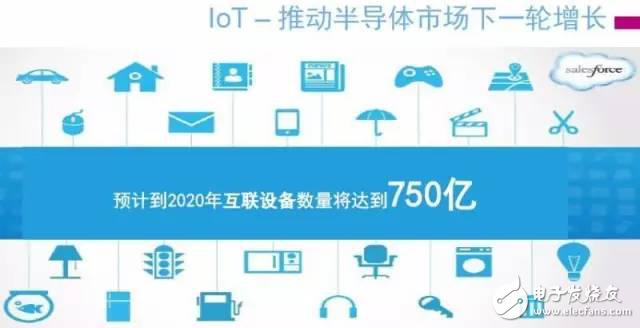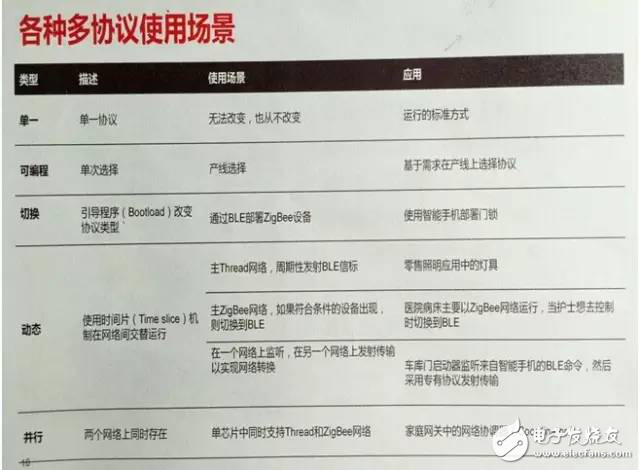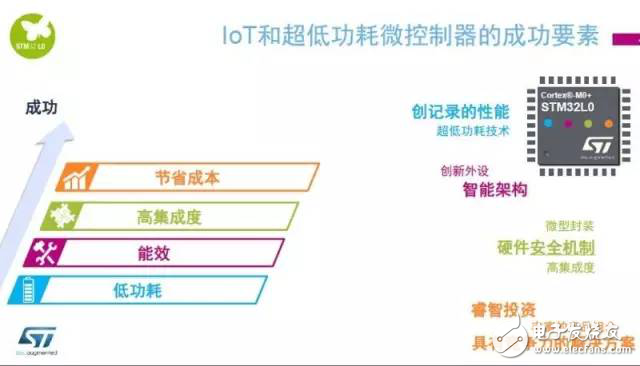From the Internet, to the mobile Internet, to the Internet of Things, the form of connectivity is undergoing earth-shaking changes. In the Internet era, it is mainly the connection between computers and networks; in the era of mobile Internet, mobile phones are connected to computers and networks. In the Internet of Things era, there will be a variety of smart products, from personal products related to mobile phones, watches, and bracelets, to home products such as automobiles, speakers, and air conditioners, to smart agriculture and smart industries. Products will be connected to each other.
According to research data, by 2020, the number of devices connected to the Internet of Things will reach 75 billion. The interconnection between these products is real-time and long-lasting, and some take years or even decades. To achieve this kind of interconnection, ultra-low power consumption becomes a key element of the Internet of Things. How to achieve ultra-low-cost connection between devices, the key to the optimization of upstream technology solutions from wireless connection technology to chips, sensors, micro-processors.

Bluetooth Release 2016 Technology Blueprint to Improve Distance, Speed ​​and MESH Networking
Bluetooth technology, Zigbee and Wi-Fi are three mainstream wireless connection technologies. Bluetooth is known for its ultra-low power consumption of point-to-point. Zigbee is known for its low power consumption and MESH self-organizing network, while Wi-Fi is transmitted with big data and high band. See you long. To enhance the application of the Internet of Things, the Wi-Fi Alliance launched low-power Wi-Fi technology, and the Zigbee Alliance announced that Zigbee 3.0 was approved. After the release of Bluetooth 4.2, the Bluetooth Alliance recently released the 2016 technical blueprint.


For Bluetooth's 2016 technology roadmap, Bluetooth technology will enable longer communication distances, faster transfer speeds and Mesh networking capabilities. At the same time, it promoted the development of its development tool Bluetooth Developer Studio and released a new Bluetooth gateway architecture release. "This year, the evolution of Bluetooth technology will further inject more momentum into high-growth industries including smart homes, industrial automation, location-based services and smart infrastructure," said He Genfei, director of the Bluetooth Technology Alliance Developer Program.
In terms of communication distance, Bluetooth Smart's range can be expanded by up to 4 times, changing the application in smart home and infrastructure, providing wireless transmission with longer transmission distance and more stable connection quality for different indoor or outdoor use scenarios. connection. Transmission speeds will increase to the current 100% without increasing power consumption, enabling faster data transfer for critical applications such as medical devices to increase response speed and reduce time delay. The Mesh networking function allows the coverage of the Bluetooth network to spread throughout the building or the entire home, allowing Bluetooth devices in the range to be interconnected, opening up more applications for smart homes and industrial automation.
At the same time, in order to promote the connection of Bluetooth devices with other connected technology devices, the Bluetooth Technology Alliance announced the launch of Transport Discovery Service (TDS), which provides a common framework for device discovery and connectivity. In the future, regardless of the wireless technology used by the device, devices can discover and connect each other through TDS. He Genfei pointed out: "TDS allows devices to operate with minimal power and will solve an important problem for the Internet of Things (IoT).
In addition, it announced the opening of the Bluetooth gateway architecture and the introduction of a starter kit to help developers quickly create Internet gateways for Bluetooth products. Bluetooth-enabled sensors can connect to gateway devices via Bluetooth technology to transfer data to the cloud and exchange data. The architecture extends the potential applications of the Internet of Things by allowing remote monitoring and control of fixed, Bluetooth-enabled sensors.
Multi-protocol SoC solution emerges to simplify IoT connectivity
There are still many ways to connect before a variety of wireless connectivity technologies are truly integrated. In order to simplify the connection of the Internet of Things, semiconductor companies began to introduce multi-protocol chip solutions.

Recently, Silicon Labs introduced the multi-protocol system-on-a-chip (SoC) Wireless Gecko product line, providing flexible connectivity and price/performance options for IoT devices. Wireless Gecko products include three series of multi-protocol SoCs optimized for IoT usage scenarios and the most popular wireless protocols: the Blue Gecko series, Bluetooth Smart connectivity, with ideal output power and transmission distance. The second is the Mighty Gecko series, the best ZigBee and Thread connection for mesh networks. The third is the Flex Gecko series, a flexible, proprietary wireless protocol option for a variety of applications.
"Multi-protocol SoC is a new concept. Specifically, it means that two protocols can be run in real time on a single chip. The complexity of different types from single protocol to multi-protocol parallel is increasing. In fact, most interested in customers. The multi-protocol product line creates smarter applications,†said Daniel Cooley, vice president of marketing for IoT products at Silicon Labs.
In the application case, Daniel Cooley pointed out the practical application in the hospital. The previous control method was mainly that there was a system control bed in the hospital nurse station. However, when the nurse leaves, he can't control it. Nowadays, manufacturers are equipped with a large number of sensors in the medical beds produced, and a mesh network is used to realize the connection and communication between the beds, the beds and the information control room of the hospital. At the same time, there are many power components inside the bed, which can adjust the position of the bed. The nurse is equipped with a tablet computer, and the action can be transferred to the tablet. When the nurse approaches the bed, the communication is switched from the ZigBee mesh network to the Bluetooth connection. The tablet can obtain the information related to the bed and carry out the bed. Manipulation; when the nurse leaves the hospital, the communication protocol of the bed will be switched from Bluetooth to the ZigBee mesh network, directly communicating and interacting with the information control center of the nurse station.
In addition, Silicon Labs introduces a plug-and-play module solution to simplify Wi-Fi connectivity. The WGM110 module is a solution for adding Wi-Fi capabilities to a wide range of devices, such as industrial/M2M systems, wireless sensors, remote controls, thermostats, connectable home products, automotive infotainment systems, point-of-sale equipment, fitness and medical equipment, etc. .
Chip vendor ideas adjust hardware, software and suites from a system perspective
Previously, semiconductor manufacturers focused on promoting technology. With the diversification of IoT applications and the diversification of application requirements, companies began to shift from focusing on technology to better meeting customer needs. From the thinking of chip manufacturers to system thinking.

In promoting the connection of the Internet of Things, ST has begun to change in promoting the development of MCU. "We're consolidating devices, software and kits from a systems perspective, not just chips," said James Wiartge, director of market and applications for microcontrollers in Greater China and Asia Pacific.
In promoting the application of MCU in the Internet of Things, there are four elements required. Hakim Jaafar, STMicroelectronics STM32 ultra-low-power and network microcontroller marketing manager, pointed out: "One is low power consumption, there will be many power supply batteries connected to sensors and sensors in the future, and the whole system will have lower power consumption. Second, how? Optimizing the power consumption in dynamic mode is very important. The battery energy is fixed, how to extend its life, you need to start from the power consumption. The power consumption is static and dynamic, and optimizing the dynamic mode power consumption is the key. The third is how to put the system It is more streamlined. Fourth, the cost, the simpler the BOM needs, which requires higher integration, lower procurement costs and manufacturing costs, and lower system costs."
For the application of the Internet of Things, the future MCU layout will be based on low power consumption, small lead angle, and wireless. In response to this, in order to introduce a sensitive microcontroller for energy efficiency, STMicroelectronics introduced the ARM CortexM0+STM32L0 microcontroller this year. The main low-power peripherals of this product include low-power ADC, which is 1000 times/second. Bit resolution sampling, power consumption of 41μA, and ultra-low-power timer (16-bit timer), can operate in ultra-low power mode; low-power mode includes stop mode, retain all RAM data and can In the case of automatic wake-up, 340nA is consumed.
With the continuous deepening of IoT applications, the competition points of semiconductor manufacturers have changed, and enterprises have begun to shift from building technological advantages to building overall solution advantages. "We don't care whether it's 8 or 32, but we care about the performance, power and cost that our customers need. What kind of kernel is the most suitable for the user." Hakim Jaafar said, "The past application is relatively simple." Now, applications will become more and more complicated, especially software and system level requirements will be more and more, it is difficult for a supplier to do Sub System alone, we will work with partners to do Sub System."
In the application case, the first is the integration of mobile phone sensors. The solution provided is MCU+sensor+partner software. This is the Sub System. The user integrates the sub system into the mobile phone, and the application system can form a complete application system. It is wearable. The solution is MCU+sensor+algorithm+display+user's own software/algorithm to form a complete system.
ER Series Battery
ER Battery,Lisocl2 Battery,ER14250 Battery,ER Lithium Battery
Shenzhen Sunwind Energy Tech Co.,Ltd , https://www.sunwindbatterylm.com